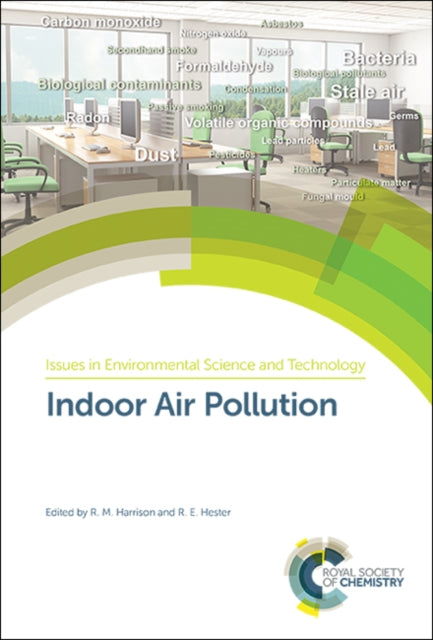Shulph Ink
Indoor Air Pollution
Indoor Air Pollution
YOU SAVE £3.36
- Condition: Brand new
- UK Delivery times: Usually arrives within 2 - 3 working days
- UK Shipping: Fee starts at £2.39. Subject to product weight & dimension
Bulk ordering. Want 15 or more copies? Get a personalised quote and bigger discounts. Learn more about bulk orders.
Couldn't load pickup availability
- More about Indoor Air Pollution
People spend around 90% of their time indoors, which is associated with exposure to air pollutants. Despite this, the only statutory requirements for monitoring airborne pollutant concentrations relate to the outdoor environment. This volume considers both chemical and biological pollutants in the indoor atmosphere and their potential effects on human health. It is a valuable reference for those working in environmental policy, civil and environmental engineering, and atmospheric chemists.
Format: Hardback
Length: 16 pages
Publication date: 12 June 2019
Publisher: Royal Society of Chemistry
Time-activity diaries kept by members of the general public indicate that on average, people spend around 90% of their time indoors. This is associated with considerable exposure to air pollutants, as not only is there infiltration of pollutants from outdoors, but there are also emissions indoors that can lead to elevated pollutant concentrations. Despite this, and the fact that the World Health Organization (WHO) produces air quality guidelines for indoor air, the only statutory requirements for monitoring airborne pollutant concentrations relate to the outdoor environment. Given its importance as a source of air pollution exposure, increasing attention is being given to pollution of the indoor environment.
This volume considers both chemical and biological pollutants in the indoor atmosphere from their sources to chemical and physical transformations, human exposure, and potential effects on human health. It is a valuable reference for those working in environmental policy, civil and environmental engineering, as well as atmospheric chemists.
The indoor environment is a significant source of air pollution exposure, and it is essential to address this issue. Chemical and biological pollutants can have harmful effects on human health, and it is important to understand the sources and mechanisms of these pollutants to develop effective strategies for mitigation and control.
One of the primary sources of indoor air pollution is the use of indoor combustion appliances, such as stoves, fireplaces, and heaters, which emit pollutants such as carbon monoxide, nitrogen oxides, and particulate matter. In addition, building materials, furniture, and cleaning products can release volatile organic compounds (VOCs) that can contribute to indoor air pollution.
Another source of indoor air pollution is the presence of biological pollutants, such as mold, bacteria, and viruses. These pollutants can cause respiratory problems, allergies, and other health issues. Mold growth, in particular, can be a significant problem in buildings with poor ventilation or moisture control.
Human activities, such as smoking, cooking, and cleaning, can also contribute to indoor air pollution. Smoke from cigarettes and other tobacco products contains harmful chemicals, and cooking can release VOCs and other pollutants from food and cooking utensils. Cleaning products can also contain harmful chemicals that can be inhaled or absorbed through the skin.
Despite the importance of indoor air pollution, there are currently no statutory requirements for monitoring airborne pollutant concentrations in most countries. This means that many buildings and homes may be exposed to high levels of air pollution without being aware of it.
However, there are several steps that can be taken to improve indoor air quality. One of the most effective strategies is to improve ventilation and air filtration. Buildings should be designed to allow for proper ventilation, and air filters should be installed to remove pollutants from the air. In addition, the use of natural ventilation, such as opening windows and using fans, can help to improve indoor air quality.
Another strategy for improving indoor air quality is to reduce the use of indoor combustion appliances and VOCs. This can be achieved by using alternative energy sources, such as electricity or natural gas, and by choosing products that are low in VOCs. In addition, individuals can reduce their exposure to indoor air pollution by smoking outside, cooking with ventilation, and using natural cleaning products.
In conclusion, indoor air pollution is a significant issue that requires attention. Chemical and biological pollutants can have harmful effects on human health, and it is essential to understand the sources and mechanisms of these pollutants to develop effective strategies for mitigation and control. Improving ventilation and air filtration, reducing the use of indoor combustion appliances and VOCs, and promoting natural ventilation are all effective strategies for improving indoor air quality. By taking these steps to improve indoor air quality, we can help to protect the health and well-being of individuals and communities and create a more sustainable and healthy indoor environment.
Weight: 516g
Dimension: 164 x 241 x 15 (mm)
ISBN-13: 9781788015141
This item can be found in:
UK and International shipping information
UK and International shipping information
UK Delivery and returns information:
- Delivery within 2 - 3 days when ordering in the UK.
- Shipping fee for UK customers from £2.39. Fully tracked shipping service available.
- Returns policy: Return within 30 days of receipt for full refund.
International deliveries:
Shulph Ink now ships to Australia, Belgium, Canada, France, Germany, Ireland, Italy, India, Luxembourg Saudi Arabia, Singapore, Spain, Netherlands, New Zealand, United Arab Emirates, United States of America.
- Delivery times: within 5 - 10 days for international orders.
- Shipping fee: charges vary for overseas orders. Only tracked services are available for most international orders. Some countries have untracked shipping options.
- Customs charges: If ordering to addresses outside the United Kingdom, you may or may not incur additional customs and duties fees during local delivery.


